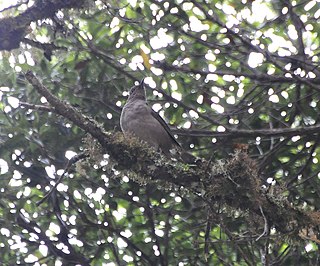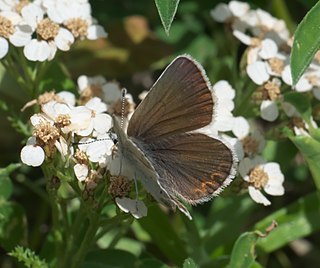
Lycaenidae is the second-largest family of butterflies, with over 6,000 species worldwide, whose members are also called gossamer-winged butterflies. They constitute about 30% of the known butterfly species.

The mountain thrush is a large thrush which is found in Central America. It was formerly known as the mountain robin. Some authorities refer to it as the American mountain thrush to differentiate it from the Abyssinian thrush, known in their taxonomy as the African mountain thrush.

Plebejus is a genus of butterflies in the family Lycaenidae. Its species are found in the Palearctic and Nearctic realms.

Plebejus argyrognomon, common name Reverdin's blue is a butterfly of the family Lycaenidae. The species is named after Jacques-Louis Reverdin.

Plebejus idas, the Idas blue or northern blue, is a butterfly of the family Lycaenidae. It belongs to the subfamily of Polyommatinae.

Icaricia icarioides, or Boisduval's blue, is a butterfly of the family Lycaenidae found in North America. This butterfly has 25 recognized subspecies.

Icaricia shasta, the Shasta blue, is a butterfly of the family Lycaenidae. It is found from the northwestern United States to southern Saskatchewan and Alberta.

Icaricia icarioides blackmorei, the Puget blue, is a butterfly native to the Puget Sound area in the northwestern U.S. state of Washington. It is a subspecies of Boisduval's blue.
Hippelates plebejus is a species of frit fly in the family Chloropidae.

Stenolophus plebejus is a species of ground beetle in the family Carabidae. It is found in North America.

Plebejus anna, or Anna's blue, is a species of blue in the butterfly family Lycaenidae. It is found in North America.

Heraeus plebejus is a species of dirt-colored seed bug in the family Rhyparochromidae. It is found in the Caribbean Sea, Central America, and North America.
Plebulina emigdionis, the San Emigdio blue, is a species of blue in the family of butterflies known as Lycaenidae. It is the sole representative of the monotypic genus Plebulina. It is endemic to Southern California.

Satyrium semiluna, known generally as the sagebrush sooty hairstreak or half-moon hairstreak, is a species of hairstreak in the butterfly family Lycaenidae. It is found in North America. The MONA or Hodges number for Satyrium semiluna is 4277.1.
Melanoplus plebejus, known generally as the plebeian short-wing grasshopper or plebeian spur-throat grasshopper, is a species of spur-throated grasshopper in the family Acrididae. It is found in North America.

Cyclargus thomasi, known generally as the Thomas's blue, Miami blue or Caribbean blue, is a species of butterfly in the family Lycaenidae. It is found in North America and the West Indies.

The eastern king prawn is an edible dendrobranch prawn endemic to eastern Australia. Its scientific name is Melicertus plebejus or Penaeus plebejus. It is caught by commercial and recreational fishers for human food.















